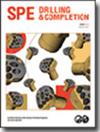利用静态和动态屈服应力的概念模拟钻杆不旋转时岩屑运移
IF 1.2
4区 工程技术
Q3 ENGINEERING, PETROLEUM
引用次数: 3
摘要
岩屑运移与钻井液流变学的关系在文献中得到了广泛的研究。尽管如此,关于屈服应力对岩屑运移的影响,仍有相互矛盾的结果报道。本研究采用静态和动态屈服应力的概念来研究屈服应力对岩屑运移的影响。提出了一种现有流变函数的修正形式来模拟静态和动态屈服应力,同时考虑了流动历史。流动方程基于混合方法,并采用计算流体动力学(CFD)方法进行数值求解。假设液相是均匀的,钻屑是非胶体的,静态屈服应力和动态屈服应力之间的区别随着体积岩屑浓度的增加而减小。Herschel-Bulkley函数预测了零剪切速率极限下的无限粘度,因此,随着动态屈服应力的增加,岩屑输运得到改善,然而,与大多数实验研究一致,所提出的流变模型表明,高动态屈服应力不利于岩屑输运。与动屈服应力相同的流体相比,静、动屈服应力差较大的流体携岩屑能力较好。然而,这些结果仅适用于屈服应力仅依赖于剪切速率的简单屈服应力流体。本文章由计算机程序翻译,如有差异,请以英文原文为准。
Modeling Cuttings Transport without Drillpipe Rotation While Using the Concepts of Static and Dynamic Yield Stresses
Cuttings transport, in connection with drilling fluid rheology, has been extensively studied in the literature. Despite this, contradictory results continue to be reported regarding the effect of yield stress on cuttings transport. This study uses the concepts of static and dynamic yield stresses to investigate the effects of yield stress on cuttings transport. A modified form of an existing rheological function is proposed to model static and dynamic yield stresses while incorporating flow history. Flow equations are based on the mixture approach and are numerically solved using computational fluid dynamics (CFD) methodology. Assuming that the liquid phase is homogenous and drill cuttings are noncolloidal, it is shown that the distinction between static and dynamic yield stresses diminishes as volumetric cuttings concentration increases. The Herschel-Bulkley function predicts infinite viscosity at the limit of zero shear rate and, hence, improved cuttings transport with increasing dynamic yield stress, whereas in line with the majority of experimental studies, the proposed rheological model shows that high dynamic yield stress is detrimental for cuttings transport. Comparing fluids with the same dynamic yield stress, the fluid with a larger difference between static and dynamic yield stresses has better cuttings carrying capacity. However, these results are only valid for simple yield stress fluids in which yield stress is dependent on shear rate only.
求助全文
通过发布文献求助,成功后即可免费获取论文全文。
去求助
来源期刊

SPE Drilling & Completion
工程技术-工程:石油
CiteScore
4.20
自引率
7.10%
发文量
29
审稿时长
6-12 weeks
期刊介绍:
Covers horizontal and directional drilling, drilling fluids, bit technology, sand control, perforating, cementing, well control, completions and drilling operations.
 求助内容:
求助内容: 应助结果提醒方式:
应助结果提醒方式:


